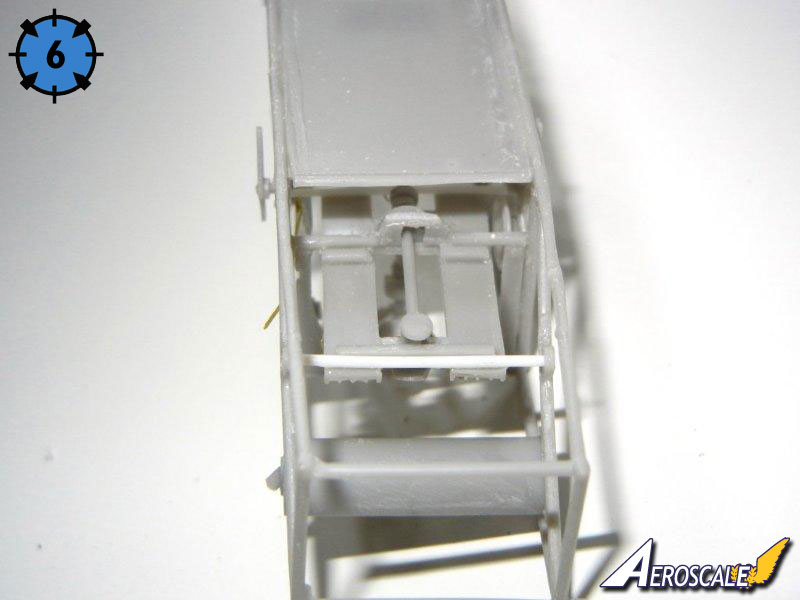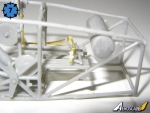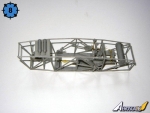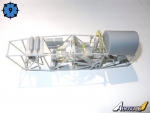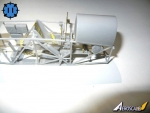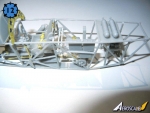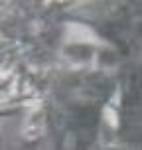1⁄32Silver Wings Hawker Hart Review Build
8
Comments
Cockpit Assembly
This proved to be the most challenging aspect of building this kit, so once you’ve got this part completed, the rest is easy J. Unfortunately, the instructions are not very clear on the location of some of the interior components. It is also easy to get the sides misaligned with each other resulting in a twisted cockpit frame assembly. The good news is that most of the cockpit frame is not visible in the finished model, so even if you end up with some twist, you can still fit everything into the fuselage (which will help untwist it some) and it will look fine when finished. For best results, I recommend the following order of assembly (see photos 6 ~ 12):1) Glue the floorboard to the frame assembly with the compass, the rear set of tabs on the bottom of the floorboard should go on the front side of the compass frame and let set. These parts should be 90 degrees to each other.
2) Begin assembly of the fuselage frame by attaching the two 22mm and one 20mm seat frame/cross-frames (with the seats), as the provided holes should ensure that your frame is aligned. Next, also attach the 21mm cross-frame that attaches under the oil tank support, as that frame also goes into holes provided in the frame. Visibly ensure your frame is aligned and let set.
3) Attach the cross-frame with the control column in its place (in line with the bumps on the outer sides of the frames), and then insert the floorboard/compass assembly from #2 above. Note that the front tab on the bottom of the floorboard should rest behind the cross-frame you attached in #3 above (see photo 6). The rod holding the control column should be just under the read of the floorboard. If you will be adding the aileron control wires (the ones that go up in a “V” from the vertical “wheel” behind the control column), attach them at this point. The ends can be glued to the behind the instrument panel once it is attached at the end of this step.
4) Attach the front 19mm and 18mm cross-frames to the frame. Check the frame alignment, and if good, insert and glue in the oil tank to the supports on each frame (see photo 7).
5) Attach the floor, ensuring that the hole is to the front, padding to the back (I installed my floor backwards and had to remove it later to correct this).
6) Attach the rear 14mm cross-frames, ensuring that both sides of the frames bend in the same amount. Once set, glue the shelf holding the two tanks into position.
7) Attach the camera into position, with the camera frame resting on top of the stubs on the fuselage side frames.
8) Attach the radio gear frame to the port side if you did not do so in the interior subassembly section above and attach the PE bulb (flare?) holder (PE21).
9) Attach the fuel tank, ensuring it is centered on the frame, and then attach the instrument panel. I put a couple small pieces of resin pour blocks on the frame to help hold the panel in place. At this time, you can run the aileron control cables up and attach them to the blocks (if you are installing them).
10) If you are installing the rudder and elevator control wires, do so now using the instructions to route them correctly. Note that these cables run on the outer side of both frames and should be mirror images of each other.
While this may seem complicated, you should be able to complete all these steps in 30 minutes or so. If you are worried about your ability to align your fuselage frames, another option is to line up both fuselage side frames, and either drill holes or notch the frames where the cross-frames should go while the two frames are aligned.
Other Subassemblies
In addition to the subassemblies needed to complete the cockpit, there are few others that can be completed as well.■ The Pott’s oil cooler can be assembled using 1mm rod to hold the PE parts. I did not worry about the lengths of the rods, and just drilled the locating holes in the bottom of the fuselage all the way through so that I could position it as desired. I would recommend not using the PE spacers between the cooling “leaves”, as they are too thin and would instead punch some similar sized discs from 5 thou sheet styrene so that the “leaves” are spaced a bit more like the real thing. Note that some Hart (India)’s had Potts coolers with 9 “leaves” instead of 5, so if the airframe you are modeling has 9, you will need to make some additional “leaves” out of 10 thou sheet styrene to fill in between the PE ones.
■ The bomb racks and bombs can be assembled as a unit, and then attached to the lower wing once the model is completed (mine fit so well I could click them into the holes without glue) since it will be easier to place the serial number decals on the bottoms of the wings without them attached. I did note that some of my bombs were missing a section of one of the three fins. If your kit is the same, you can add the missing part using sheet styrene. Also be sure to note that the front and rear brackets are different, and that the wider bracket goes toward the front. You can leave the bombs off the racks until final assembly if you wish.
■ You can assemble the gunner’s scarf ring and MG at this point, or wait until the fuselage is assembled if you wish to test fit it before assembly. I am not sure about the site on the front of the gun, but it looks good there nonetheless.
■ If your model carried radio equipment, drill holes in the appropriate locations on the upper wings and rudder. Fabricate the attachment posts out of some styrene or metal rod, and install them at this point, or wait until you have painted and decaled your model.
Comments
Nice to see some "Tweeners" being released. Nice too to see a two seater.
Do they do a Fury or a Demon?
Cheers,
Hugh
AUG 16, 2011 - 01:16 AM
Hi everyone. Thanks to Rowan for inviting me to post this "build guide"/review here.
I wanted to see if I could get some feedback on what your thoughts are on this type of review. Is it too long, too short, too detailed, not detailed enough etc. Is there any benefit to you, the reader, in seeing the build without paint, or would you prefer to see it painted?
This is the first review of this type I have done, so please let me know how I can improve it - don't be shy - I am a big boy and can take harsh criticism if necessary!
Thanks!
Doug
AUG 17, 2011 - 09:03 AM
Hi again
I always used to read Model Aircraft Preview, and found their "nothing to hide behind" style really useful in judging a kit - often more so than a finely finished model that often said more about the skills of the builder than the quality of the kit.
We've seriously considered running reviews in this style on Aeroscale in the past, so I'd also be very interested in seeing readers' feedback on it and whether it's something you'd like to see us do regularly for standard releases.
All the best
Rowan
AUG 17, 2011 - 10:41 AM
Doug and Rowan,
I found this review very informative and probably just a tad too long although for the subject in question it may be right. I think without seeing this done on another subject, never having seen the magazine in question, it is hard to judge.
The one question I have is what do you do with the made up kit now as you can not get inside to paint the interior? Myself I would not want to do this type of review but yes I did find it helpful.
AUG 17, 2011 - 11:47 AM
Hi Luciano
Probably the reason more people aren't prepared to do a review like this is that the kit truly is "sacrificed" for the sake of showing how well it fits together (or otherwise). It sort of goes against every modelling instinct - a really tough decision to make, especially with a limited edition resin kit like this one!
All the best
Rowan
AUG 17, 2011 - 11:59 AM
Building it with out painting and filling is helpful, and shows how the kit really is, and how much work is needed correcting seam lines and whatnot.
I have done the same type of review myself with a HobbyBoss F-16D Fighting Falcon , and although I did enjoy building it this way, it's not something I would like to do on a regular basis, unless I had two of the same kits and one could be "sacrificed" (but how often is that going to happen ).
Andy
AUG 18, 2011 - 02:56 AM
Nice review Andy!
@ Luciano - this kit will likely never see paint, as it has served its purpose as a review kit. I actually think it looks pretty good as is, but I just need to figure out where to put it
@ Hugh - Montex did a 1/32 Fury which was mastered by the owner of Silver Wings before he started his own company. Ali @ A2Zee Models is now is the vendor for this kit and sells it with upgraded metal struts and proper 43 squadron decals. No one does a Demon that I know of, so if you really want one, you'll need to convert the Hart to get one
Regarding reviews, I personally find it easiest to do the non-paint (and non-rigged for biplanes) reviews as I can get it done much faster when I don't need to plan painting/filling/decaling etc into the mix. And as some of you mentioned, the benefit is the reader gets to see how the kit is without anything "hidden" by filler and paint.
As I was given this kit to review, and I have my own copy in the stash, I thought this review would be a good way to get to learn about the kit, and provide a useful review at the same time. I think doing the review kit this way will help me do a better job building my own Hart kit
I'm currently working on the same type of review for the Silver Wings Gloster Gladiator, and I'll submit it for posting once it is complete.
Thanks for your comments (and for anyone else that wants to provide feedback!!) and to the emailed comments I received as well.
Cheers,
Doug
AUG 18, 2011 - 09:35 AM
Copyright ©2021 by Doug Nelson. Images also by copyright holder unless otherwise noted. The views and opinions expressed herein are solely the views and opinions of the authors and/or contributors to this Web site and do not necessarily represent the views and/or opinions of AeroScale, KitMaker Network, or Silver Star Enterrpises. Images also by copyright holder unless otherwise noted. Opinions expressed are those of the author(s) and not necessarily those of AeroScale. All rights reserved. Originally published on: 2011-08-11 00:00:00. Unique Reads: 11932




